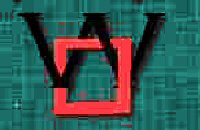 Analyses of all verses
Analyses of all verses
|
 Web Site
Web Site |
 All
Sefirots All
Sefirots |
|
Sects and the Seeds of
Destruction -2054.
|
Factors relating to the wars of the 21st Century.
C1 Q56
Sooner and later you will see great changes made,
dreadful horrors and retaliations.
For as the moon is thus led by its angel
the heavens draw near to the tipping point.
Vous verrez toSt et tard faire grand change
Horreurs extremes et vindications
Que Si la lune conduicte par Son ange
Le ciel s'approche des inclinations.
This verse is multi-layered and its astronomic layer plays a significant part in my identifying the period of Nostradamus' great mutations as being the 100 years from 2000CE to 2100CE. This latter date is the time when the Polestar (Polaris or Cynosurae), draws to its highest point in the northern sky. The moon led by its angels is a reference to how the moon waxes and wanes and the timing of it is signalled by the twenty-eight mansions (i.e. angels) that the moon occupies. As Polaris approaches the North Pole it too is changing signs.
Through Nostradamus' terminology ('the heavens draw near to the tipping point') we can understand that the verse is based around the years leading up to 2100. However Nostradamus also uses the term 'sooner' which implies additional events closer to his own time.
In other material on my website I include a disastrous event that takes place in Geneva in 2065CE. This is a trigger point and is linked to a constant theme on actinides (or actinoids as they are more commonly called in modern times). The actinoids are the elements around which nuclear technology is built as they are all sources of radioactivity. This word 'actinoids' appears as an anagram at the end of line two and only occurs in one other verse (C2 Q69 L.2).
The anagrams hidden in other layers of the above verse create an image of the earth's oceans and land masses changed in their nature by fallout from the air. The first line tells us that over-confidence leads to a test program bursting into flames and the drifting pollutants in the atmosphere spread the danger ( AIR.DRAFT.TO.CHANGE.DANGER.OVERSURE.TEST AFIRE).
The second line amplifies this theme as it holds unique anagrams such as hornitos and actinoids which refer to volcano-like eruptions spilling out radioactive actinide-series material. Such words surely are in tune with the visible threat of dreadful horrors and retaliation.
Furthermore mutation from fallout equates strongly to the term 'great changes' used by Nostradamus in his text. In this case we see it as applying to the genetic codes of all life forms in the path of the air-stream.
The
last line of this verse holds a combined anagram that measures the scale
of the event for it holds
sad-prophecies (s'approche des i) but it also details the environmental impact since it holds
unique anagrams for
pedospheric
(organic surface layer of
soil),
sapropelic
(marine
sediment
rich
in
organic
material) and a
rare anagram of
coastline. These unique and rare anagrams
form a pattern that enhances the meaning of the verse especially given the
connection with
other events
in
1065
that
I
have outlined previously.
In re-using this verse I have
re-established the thread to 2065CE and shown how closely it ties in with
the events of that time. And from the foundation of this verse I will build a
picture of the war's proponents.
The Sects that aroused Nostradamus' interest.
In order to explore the identity of the sects that are at the source of the wars of this century we need to know which names can be found as anagrams and which cannot. Anagrams do not provide a simple license to invent themes for their existence is limited and it is nigh impossible to find ones with relevance to each other and the text. If it were not so then there would be far more anagrammatic code of significance in all literary works. So it is relevant to compare those anagrams that appear in Nostradamus and those which don't.
There is a clear pattern that emerges when this is done. It immediately becomes apparent from looking at those that are missing from the list and comparing it to those that are, that chance is unlikely to be the generator.
The following is a list of names of sects that are not mentioned via anagrams in Nostradamus' Prophecies, nor are their derivative forms (such as Adventist/s for Adventism). :
Adiophorism, Adventism, Albigensian, Amyraldism, Anglicanism, Arminianism, Brownism, Buchanism, Congregationalism, Christadelphianism, Darbyism, Ecumenism, Episcopalian/ism, Freechurchism, Hueguenotism, Labadism, Irvingism, Lollardism, Methodism, Mormonism, Pajonism, Presbyterianism, Scientolog(y/ist),
Benedictine, Dominican, Franciscan, Jesuit. Catholicism.
Islamic, Mahommed, Muhammad, Mahommet,Moslem, Muslim, Shiah, Shiite
There are also no anagrams for Atheism, Agnostic or Irreligious.
The names that are found therefore highlight the nature of Nostradamus' interest; it is the mainstream Protestant religions and the Gnostic sects. Before showing the evidence for this I should comment on a result that many people will find surprising.
There are no substantial anagrams for Islamic religions. Mahomet does occur six times but it is always also present in the text. And although Islam occurs over twenty times the lettering is too simple for its accouurences to be conclusive. There is a one occurrence of mosque in C8 Q72 that is relevant.
However, C3 Q44 is the only verse where the Islamic theme can be considered as highlighted via Nostradamus' anagrams. It contains anagrams for allah, mollah, Islam and mohommed.
Despite extensive searches there is nothing I have found that suggests Nostradamus foresaw a great prominence of Islamists in his theme of Religious Wars. And this is true of both the Epistle and the Preface where there is only a very cursory mention of Islamic involvement. This is not to say they aren't participants but it is those sects closer to France that were Nostradamus' main interest.
There are other solid reasons why he would have chosen this course. He only needed one allusion to signify the divisive drag of time on different faiths and the Protestant cause came to prominence in his time, making it the perfect instrument for his past, present and future themes.
The following list shows the name and place where sects are identified in a single verse of the Prophecies:
Genevanism (= Calvinism) C10. Q51 L.3
Lutheran C9 Q50 L.1
Pentecostalism C4 Q13
Laudianism (= English 17th C anti-puritanism) C6 Q31 L.4
Hussite(14th C Bohemian reform movement ) C9 Q40 L.4
Abecedarians (16th C German- disdain of human knowledge) C5 Q25.4
Waldensian (as UUaldensian 16th C Northern France Calvinist movement) C9 Q72 L.4
Manicheans(Persian Gnostic religion) C8 Q70 L.1
Essenes (2ndC BCE to 2ndC CE ascetic Jewish sect )C6I Q74 L.3
There are some sect names that occur more frequently as anagrams in Nostradamus' Prophecies but their lettering is sufficiently complex as to be worth mentioning especially as many of these names link directly to verses with details that expand on religious themes
Lutheranic C4. Q44 L.3 & C5 Q 43 L.3
Calvin C4 Q44 L.3 & C7 Q19. L.2 (also Cauvin).
Nestorianism (Eastern gnostics) C1 Q36 L.3 & C3I Q87 L.2
Nestorians C5 Q41 L.3, C5 Q63 L.4 & C 6 Q17 L.2
Cathars (Sthrn France gnostics- destroyed in 13thC Crusade) C5 Q58 L.3 , C5 Q61 L.3 & C10 Q5 L.3
Essaoi (Grk for Essenes) C1 Q100 L.1, C2 Q75 L.3 C3 Q11 L.1
Herodian/s (Essenes believing Christ a Prophet) C6 Q94 L.2, C9 Q52 L.3
Zealots (Essenes reliant on military action) C1 Q79 L.1, C6 Q50 L.3
Some but not all of these fulfill the rules that mark them as special keys and the trails set by them are followed in the chapter on Religious Wars.
The discussion in my next article begins with just two words from this list, Lutheranic and Calvin, since the verses in which they are found encompass themes which are of a great deal of relevance to Nostradamus' mutations. There is also a single line of verse where these two names appear together (CIV. Q44 L.3) but the import of this is for now directed only at the unlikelihood of this occurring by chance.
The alliance of Lutherans, Calvinists and Nestorians.
The first verse I will analyse (C5 Q43) is worded in a way that immediately suggests it is relevant to the sectarian theme in Nostradamus' Epistle to Henry.
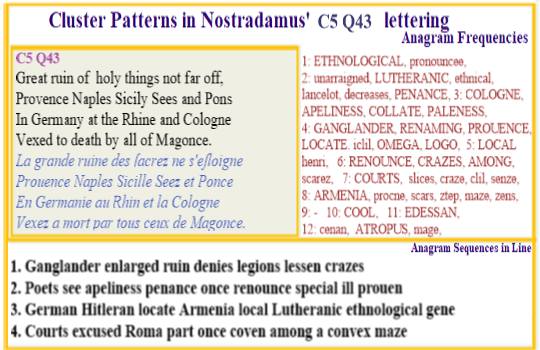 The following anagrams are found only in this verse Lutheranic
(L.3
u Rhin et la
C),
Ethnological
(
hin et la Cologn) and
Mozart (L.4
z a mort)
The following infrequent anagrams are also found but they are not
of singular occurrence
Edessan
(L.1
ne
des
Sa),
Armenia
(L.3
rmanie
a),
Europe
(e
Proue).
These words reinforce the message of the
text suggesting that this involves a sect that
plays
prominent
roles
in the
mutation
of
religion.
The following anagrams are found only in this verse Lutheranic
(L.3
u Rhin et la
C),
Ethnological
(
hin et la Cologn) and
Mozart (L.4
z a mort)
The following infrequent anagrams are also found but they are not
of singular occurrence
Edessan
(L.1
ne
des
Sa),
Armenia
(L.3
rmanie
a),
Europe
(e
Proue).
These words reinforce the message of the
text suggesting that this involves a sect that
plays
prominent
roles
in the
mutation
of
religion.
In his Epistle to Henry in 1558 Nostradamus described the creation of a triumvirate formed between two Northern sects and an Eastern sect. It was this union that heads his list of events that see the greatest mutation of religion ever seen, the outcome of which is that the old institutions will be completely displaced.
"And all these Eastern Kings will be chased, overthrown and exterminated, but not altogether, by means of the Kings of the North, and because of the drawing near of our age through the three secretly united in the search for death, treacherously laying traps for one another. This renewed Triumvirate will last for seven years and the renown of this sect will extend around the world." Nostradamus Epistle to Henry 1558
The verse above clearly tells the same story and it adds detail especially in regard to European locations. Interestingly this verses anagrams also gives locations but the main emphasis is on the Eastern sites not the European. The visible text's named locations act as a signal as to the identity of the sects for they are where Lutheran, Calvinist and Cathar histories developed. Correspondingly, the hidden places are those with Nestorian connections. This verse carries anagrams for Edessa/n, Urhai (= Edessa ) and Armenia , all places that played important parts in the history of the Nestorians. There are other relevant anagrams in this verse but their import is for a later telling. At the present time it is enough to see that it holds an anagram of Lutheranic in its third line and brings out specific regions associated with the names of sects that are hidden in Nostradamus' prophecies. It is in these named places that the events of the years following 2054CE are likely to have their origin.
 The word
Calvin is also found in two verses and the one that is of immediate
interest is C7 Q19 because this is the verse
with
some
of
the
most
inexplicable
sets
of
anagrams
one
could
expect
to
find.
The word
Calvin is also found in two verses and the one that is of immediate
interest is C7 Q19 because this is the verse
with
some
of
the
most
inexplicable
sets
of
anagrams
one
could
expect
to
find.
The anagrams formed as a complete sequence from the third line say Budapest's governmental factions and other anagrams identify actinides as the base of strange weapons.
The anagram of Calvin is found wrapped around the ends of the second line. But Cauvin, an anagram of Vaincu that is at the start of the second line, also identifies the same man since Jean Cauvin is the name which John Calvin was given when born in Noyon, France.
These two verses also hold another link. Although most commentators on Nostradamus' prophecies take Nicene to mean Nice, France there is no compelling reason to do so. Well before I wrote this current paper I had established connections based on religious ideas going back to the Nicene Council in the 5thC I had always felt that Nicene in this verse should be applied to Nicea, Turkey , the place where the Nicene Creed was crafted. The Nicene creed was designed to target exactly the heresies embodied in Lutheran, Calvinistic and Nestorian tenets. And Nicea is in the near-east, the region in which Edessa and Armenia are located. It is a fact of history that the Protestant religions have played prominent roles in this region and it is from these past alliances that credibility emerges for a future alliance.
But now it is time to look more closely at verses that relate to Hungary since this last verse takes on more and more of a central role in keeping with the strength of its anagrams and it focuses attention on Budapest, Hungary.
Sects in Hungary and Budapest.
As in most modern societies there are many sects in 21st century Hungary and Budapest. The most prominent ones are the Catholic Church, accounting for 60% of believers; Calvinist Reformed Church (18%); Evangelical Lutheran Church(4%) and the Jewish community with 1% of believers. Apart from this, there are old, established churches which have been in existence at least since the 19th century such as Baptists, Adventists, Methodists and Pentecostals, and new churches which have sprung uafter the regime change in 1989. Islam is not very visible in Hungary .
There are thirteen quatrains in which Nostradamus specifically mentions Hungary either by its more recent name, (H)ongrie (5 times), or by its Roman name, Pannonia (8 times). The second term actually covers a much larger area than the first since it includes part of Austria (uto Vienna) and much of Serbia, Croatia and Yugoslavia. I will begin with one of those in the Hongrie series since it contains important anagrams that help define the nature of some sects other than those already identified.
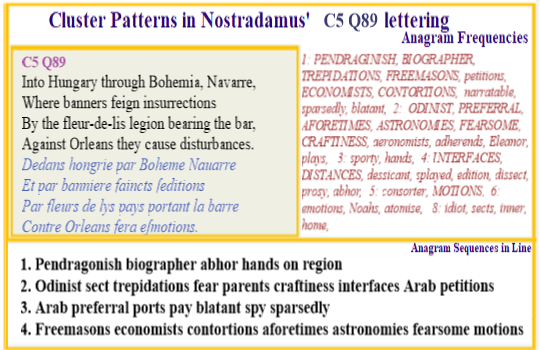 This verse
(C5 Q89) is full of symbolic references. The
Fleur-de-lys with bar
was and still is the emblem of French Royalists
- supporters of the house of Bourbon. It is the symbol used by sects that
seek the restoration of the Bourbon line to the throne of
France
.
This verse
(C5 Q89) is full of symbolic references. The
Fleur-de-lys with bar
was and still is the emblem of French Royalists
- supporters of the house of Bourbon. It is the symbol used by sects that
seek the restoration of the Bourbon line to the throne of
France
.
And hidden in this quatrain's anagrams there is the word sects (cts se) an anagram that only occurs eight times in the Prophecies.
Additionally in this verse there are at least two names of sects that occur nowhere else. The last line holds an anagram of Freemasons (ns fera esmo) while the second line has a series of sequential anagrams which say in Odinist sects (in ctsSe ditions).
The second line also holds sects.in.fear.arab.nine.petitions and trepidations.ban.craftiness. The message in this line is about fears one or more groups has about the aspirations and intentions of another section of the population and this is the same message carried in the text. The Odinist sects fit well to the Northern King messages in Nostradamus' Epistle to Henri of 1558. It also fits well to the idea of nine petitions since the Odinic cults place a large import on the division of ideas and ceremonies into nine parts.
Freemasons do exist in Hungary and Budapest and at different times in the last few centuries the organisation has had a strong membershiwhich evolved from an even stronger presence of the Masons in Austria (Bohemia). Although there is only this one anagrammatic reference to the Freemasons in the Prophecies there appears to be a link to the Masons in at least one other verse containing an anagram of sects.
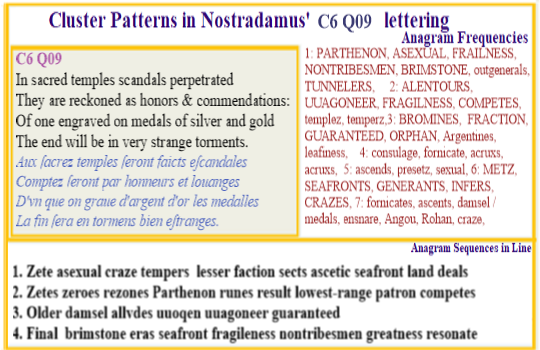 The
symbolism of the verse alongside (C6 Q09) is strongly Masonic with references to some of the
most notable elements of
Masonism namely the act of engraving, the
high status
of the temple and
their
use
of a system of honours (degrees).
The
symbolism of the verse alongside (C6 Q09) is strongly Masonic with references to some of the
most notable elements of
Masonism namely the act of engraving, the
high status
of the temple and
their
use
of a system of honours (degrees).
But at this point I need
go no further with the analyses of these two verses for my aim was to show
that there is a small list of names of sects
contained
within Nostradamus'
verses
and that
Freemasonry seems to be part of the events that
are
linked
to Hungarian
actions.
And
it is possible to find
further
links to support the
Odinic reference. There is for example one verse,
C4
Q25, that holds an anagram
for
Odinism
(L.4
son
Dimi)
and
the
tone
of
this
quatrain
is
distinct
from
most
of
the
other
verses
in
the
Prophecies
of
Nostradamus.
This
verse
is
often
referred
to by
commentators
on
Nostradamus'
Prophecies
as
being
an
occult
prayer.
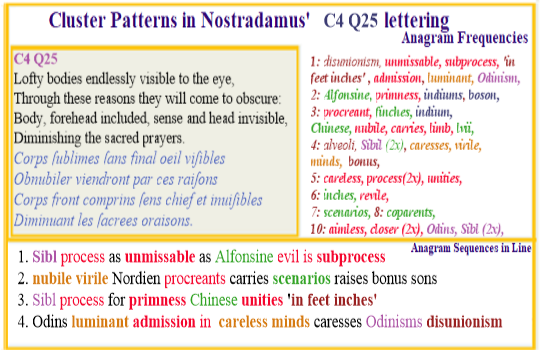 Is
the
tone
of
this
verse
Odinic or what?
Is
the
tone
of
this
verse
Odinic or what?Compare both its tone and message to lines found in the Runatal where Odin says:
I mind I hung from that windswept tree, hung there for nine long nights;
I was pierced with a spear; I was an offering to Odin, myself to myself.
No one has ever known or will ever know the roots of that ancient tree.
No one came to comfort me with bread, no one revived me with a drink from a horn.
I peered at the worlds below; I seized the runes, shrieking I seized them; then I fell back.
SHAKESPEARE's DREAM 1596-2054CE
The origins of the wars of this century are identified by Nostradamus in his Epistle to Henry as being tied to two Northern kings and one Eastern king who unite in an evil, destructive pact even though the sects to which they belong differ. This emphasis of his is the reason why I have focussed on verses whose content is about sects. One of the strongest in this regard is Quatrain 45 in Centuries I (C1 Q45) and for that reason I include it here.
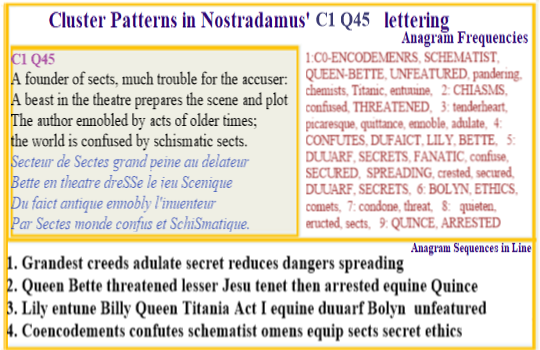 The
extraordinary thing about this verse is the accuracy with which it relates
to an event that is totally unexpected and its relevance isn't easily
explained. My immediate
task
is to show why I am convinced
there
is
a
clear
reference
in
Shakespeare's
Midsummers Nights Dream
to
the
sects
that
interested
Nostradamus.
The
extraordinary thing about this verse is the accuracy with which it relates
to an event that is totally unexpected and its relevance isn't easily
explained. My immediate
task
is to show why I am convinced
there
is
a
clear
reference
in
Shakespeare's
Midsummers Nights Dream
to
the
sects
that
interested
Nostradamus.
The second
and third lines of the above verse hold the clues. This particular play of
Shakespeare was first presented in the
Theatre in
Shoreditch in 1596CE (1597 was the year that the Globe was built and first
used by Shakespeare).
A most memorable part of the play is when the
character Bottom is transformed into a
beast with a donkey's
head. The play also contains
an internal play to be put
on by Quince, Bottom and co. This internal play is presented as
being authored by the leader of the troupe, Peter Quince, who draws his
tale from a story of love and death in the olden-time classic, Pyramus and
Thisbe.
All
of
this
fits
to
what
we
can
read
in
this
verse.
But
in addition there is the peculiar sound of the second line's
Bette in the theatre since it resonates
as
Elizabeth
in the
theatre or in the Theatre in
Elizabethan times. Of course my conclusion had other material on which I
could draw besides
the
foregoing
visible
elements of this particular
verse.
The quatrain is full of anagrams that apply to
Shakespeare's play. The name of the author of the olden-time play,
Quince, is found in the second line as
ceniqu. There is
dwarf (as duuarf) in the
third line
and Puck,
another major character
in
Shakespeare's
play,
is referred to as a dwarf
in the play
when
Lysander
says 'Get you gone you dwarf'. The third
line also contains
Queen.Bol'yn tying the verse to the
monarch Elizabeth via her
mother
and
this
is
the
only
place
where
such
an
anagram
can
be
found.
This
line
may
add
more
and
say
Queen
Boleyn
invent
dwarf.
It is also possible that the words
faict antique ennobly in the third line were, as shown in many
versions, originally written as
fait antique ennobly from which
we would then have
Queen.Titania (aitanti queen) , the
name of the Fairy Queen in Shakespeare's play.
If, as I have shown,
this verse is about Midsummer's Nights Dream how did it serve Nostradamus' ends?
It must do so by analogy and by yielding a date that fits into '
the sooner' part of Nostradamus' claim
that
Sooner and later you will see great changes made. A date
relating to the action of three sects in this century can be determined by
the use of the 458 years displacement method of dating (i.e. sooner and
later method). By this means 1596 becomes the year 2054CE and in this
latter year we may expect that the founder of sects
concealed
in
Shakespeare's
play
will be active. This
year is eleven years before 2065CE and the events that trigger the wars
all of which is in accord with Nostradamus' message in the Epistle to
Henry.
...the persecution of the Ecclesiastical folk will have its origin in the power of the Kings of Aquilon united with the Easterners. The persecution will last for eleven years or somewhat less, for then the King of Aquilon will fall.
Then in the same year, and in those following, there will ensue the most horrible pestilence, made more stupendous by the famine which will have preceded it.
The religion of the name of the seas.
There is no doub t that the nature of my writings is bizarre, since it seems impossible that the anagrams I have identified should occur, especially in English. The easiest action for any reader is to assume that it is too impossible and therefore isn't worthy of any further thought. However it isn't unknown for events considered impossible to be proven right. Stones falling from the sky, a cannon-ball not falling faster than a light pebble, the sun being more than 4,000 years old, the speed of light being the highest speed possible, all were once thought impossible. And in each case the contemporary reasoning behind this way of thinking seemed reasonable. What changed the essence of each debate was evidence.
It isn't to say that all bizarre observations are then going to change our perception of the world or universe but observation is indeed the cornerstone of change. But there is still a fundamental rule that applies to every change in thought and that is that any evidence presented must lay within an envelope of consistency with all that we already know about the world.
In an earlier section I highlighted that we
can't expect to gain full insight into events we can change and this is
one of the consistencies in logic that must be applied to my evidence. To
say that it is impossible to see full details of any change can be fairly
claimed because it is based on an immutable foundation; the future can't
be the future if you can change it. Equally any detail that unfolds from
Nostradamus' writing applies to the immutable and neither Nostradamus nor
I claim any more than that. Of course this leaves many enigmas but the
resolution of these lies in the future at a time when the evidence is no
longer in dispute. However there can be no revelation by me about the
coming war that any living person can use to their advantage, and this
isn't a contrarian act
on
my
part
but a barrier
within
knowledge
itself
and it is the same sort
of barrier that confronted
Nostradamus.
Of the three sects that which is in the middle, because of its own partisans , will be thrown a bit into decadence. The first one will be exterminated throughout all Europe and most of Africa by the third one...Nostradamus in his Epistle to Henry, 1558
In much of the analyses I have shown considerable detail that will make it easier to judge both Nostradamus and my own writings but whenever I search for the participants in the wars of this century I find that there are constant barriers. I know the verses in which the answers most likely lie, but that is as far as I can go. Two such verses are worthy of mention here as they illustrate my point. The first of these, C10 Q96, is one of the verses with strong statements about the role of a sect.
 The second line of this verse is full of anagrams such as
faction and
infector that tie it
into my theme of the sects as outlined earlier but it also holds the
key to verses that enlighten Nostradamus' text. The first of these of any
importance is the anagram for
nautical (aluncati) since
nautical is the word applied to name objects and persons found on
the seas.
The second line of this verse is full of anagrams such as
faction and
infector that tie it
into my theme of the sects as outlined earlier but it also holds the
key to verses that enlighten Nostradamus' text. The first of these of any
importance is the anagram for
nautical (aluncati) since
nautical is the word applied to name objects and persons found on
the seas.
There are four other places where this same word occurs as an anagram and one of these is verse C10 Q68 Line 1 which says: The army of the sea will stand before the city, (L'armee de mer deuant la cite tiendra).
In both the above cases where this anagram occurs there is the reference to those of the sea and in each the anagram of nautical exists independently of these words. But in the second example there is also an anagram of the word Atlantic (antlacit). And through this link another verse is connected to these two since C3 Q,79 L.4 contains both nautical and Atlantic and its wording says The city taken, the enemy at the same time (La cite prinSe l'ennemy quant et quant). Significantly these last two lines of verse are the only two that contain an anagram for Atlantic .
There are other links but those presented here show the reason why I conclude the religion of the name of the seas relates to Western religions based around the Atlantic . Following this trail I can identify Marseilles as the city under threat (C3 q.79 L.3) but I could also show that the threat is once again from anti-particles (C3 Q,79 L.4 ant la cite prins). However this takes me away from my point in presenting the original verse about these sects.
The second line of the verse shown above ( C10 Q96) holds some powerful strings of adjacent anagrams that build a consistent picture. They say Asad lunatic sect alte life and Salafid telecaster stifle tolerances. There can be little argument that this is new material that aptly applies to the themes I find in Nostradamus' Prophecies but despite all this detail it tells us nothing that we can use to change events even if it is totally valid. All we have is the guide to the proponents in what is about to enfold. All those who have attended sporting events will know that form guides and lists of players tell you nothing about the way the game will twist and turn.
END of PAGE